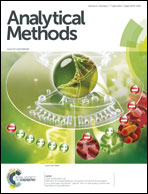Detection of PFOS and copper(ii) ions based on complexation induced fluorescence quenching of porphyrin molecules†
Abstract
Finding a highly sensitive and specific, but technically simple method for the detection of the anthropogenic pollutant, perfluorooctane sulfonate (PFOS), is a worthwhile yet challenging undertaking. In this article, it was found that both PFOS and copper(II) ions can form complexes with cationic porphyrin molecules, resulting in the fluorescence quenching of these molecules. However, when the quantitative analysis of PFOS was performed, the interference of copper(II) ions could be eliminated by additionally introducing 0.1 mM of EDTA into the sample, and similarly, the influence of PFOS on the quantitative analysis of the copper(II) ions could be eliminated using powder activated carbon to remove them from the samples. Therefore, a fluorescence quenching method for the detection of PFOS and copper(II) ions in the same sample was developed, using cationic porphyrin as the optical probe, which has the advantages of technical simplicity, high selectivity and sensitivity.


 Please wait while we load your content...
Please wait while we load your content...